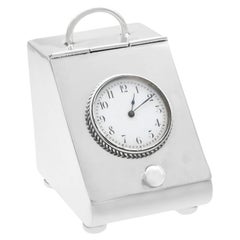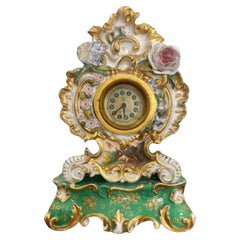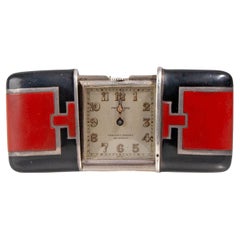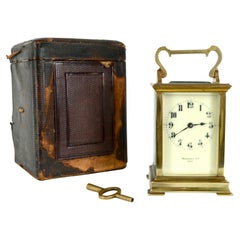Velvet Carriage Clocks and Travel Clocks
to
1
1
1
1
9,732
201
100
58
47
1
1
1
1
Height
to
Width
to
1
1
1
1
Material: Velvet
Antique Edwardian Sterling Silver Jewelry Box and Watch
Located in Jesmond, Newcastle Upon Tyne
A exceptional, fine and impressive, antique Edwardian English sterling silver jewelry box and watch modeled in the form of a coal scuttle; an addition to our silver timepiece collection.
This exceptional antique Edwardian sterling silver jewelry box and clock has been modeled in the form of a coal scuttle, with a plain trapezoid form and rounded lower edge all supported by four bun feet.
The surface of this impressive antique silver jewelry box is plain and unembellished.
This impressive antique clock...
Category
Early 1900s English Edwardian Antique Velvet Carriage Clocks and Travel Clocks
Materials
Silver, Sterling Silver, Enamel
Related Items
Antique Edwardian Quality Hand Painted Porcelain Mantle Clock
Located in Ipswich, GB
Antique Edwardian quality hand painted porcelain mantle clock having a quality hand painted decorated porcelain clock case with flowers, leaves an...
Category
Early 20th Century Edwardian Velvet Carriage Clocks and Travel Clocks
Materials
Porcelain, Glass
1920s Art Déco Swiss Sterling Silver and Enamel Movado Ermeto Watch/Chronometer
By Movado
Located in North Miami, FL
1920s Art Déco Swiss sterling silver and enamel Movado Ermeto expandible watch/chronometer
By: Movado
Material: silver, sterling silver, enamel, metal, glass, crystal
Technique: cast, molded, metalwork, polished, silvered, enameled
Dimensions: 0.5 in x 2 in x 1.5 in
Date: early 20th century, circa 1920
Style: Art Déco
Place of origin: Switzerland
A 1920s Movado Ermeto pocket chronometer, crafted in sterling silver with black and crimson red enamel. This Art Déco piece features a retractable case that expands to reveal the time, complemented by Arabic numerals and a winding crown at the top. The case is adorned with geometric enamel patterns in vibrant hues, contrasted by polished silver borders that emphasize its sleek, modernist form.
Notably, the interior bears the maker’s marks, including "Movado" and "Carlos U. Perret," a prominent Argentine importer, alongside the purity hallmark "0.935" indicating the high-grade silver. In 1926 Movado Ermeto watches...
Category
1920s Swiss Art Deco Vintage Velvet Carriage Clocks and Travel Clocks
Materials
Crystal, Metal, Silver, Sterling Silver, Enamel
H 1.5 in W 2 in D 0.5 in
Beautiful Edwardian Sterling Silver Table/Jewelry Box With Pull-Out Drawer
Located in New York, NY
Beautiful, Edwardian period, sterling silver table/jewelry box on ball feet, having a hinged lid and a pull-out drawer (which has a lovely, hinged handle). The box was made in Chest...
Category
Early 1900s English Edwardian Antique Velvet Carriage Clocks and Travel Clocks
Materials
Sterling Silver
H 2 in W 6.25 in D 4.75 in
Antique Edwardian quality mahogany inlaid mantle clock
Located in Ipswich, GB
Lovely antique Edwardian quality mahogany inlaid satinwood mantle clock having a lovely antique Edwardian quality mahogany mantle clock with inlaid satinwood detail to the case, shap...
Category
Early 20th Century Edwardian Velvet Carriage Clocks and Travel Clocks
Materials
Mahogany
Antique Edwardian Mahogany Desk / Mantel Clock
Located in Ipswich, GB
Antique Edwardian Mahogany Desk / Mantel Clock with string inlay around the edge having a round enamelled Arabic dial and French movement.
Category
Early 20th Century Edwardian Velvet Carriage Clocks and Travel Clocks
Materials
Mahogany
Austria 1910 Edwardian Guilloché Enamel Miniature Boudoir Clock In .950 Sterling
Located in Miami, FL
An Edwardian miniature boudoir desk clock, designed by Richard Silverer.
An exceptional boudoir desk clock, made in Vienna Austria during the Edwardian period, back in the 1910. The craftsmanship of this clock is exceptional and was made with gorgeous neo-classic patterns at by the Viennese silversmith Richard Silverer. This beautiful desk clock was crafted in solid sterling silver .950/.999 and mount in a rectangular base with four round sabots. The neoclassic design composition is reinforced by two thin columns centering the round dial and is topped with a curved French roof...
Category
Early 1900s Austrian Edwardian Antique Velvet Carriage Clocks and Travel Clocks
Materials
Silver, Sterling Silver, Enamel
H 2.95 in W 1.9 in D 1.25 in
Edwardian 1908 Miniature Guilloché Blue Enamel Clock in .935 Sterling With Case
By Concord
Located in Miami, FL
An Edwardian miniature travel clock.
An outstanding antique miniature travel-carriage boudoir clock, made in Geneva Switzerland by the Concord Watch Co. This little antique clock is...
Category
Early 1900s Swiss Edwardian Antique Velvet Carriage Clocks and Travel Clocks
Materials
Silver, Sterling Silver, Enamel
H 197 in W 1.1 in D 0.97 in
Antique Edwardian quality mahogany inlaid mantle clock
Located in Ipswich, GB
Antique Edwardian quality mahogany inlaid mantle clock having a quality mahogany inlaid case with a brass bezel, circular dial, original hands, 8 day movement striking on the hour an...
Category
Early 20th Century Edwardian Velvet Carriage Clocks and Travel Clocks
Materials
Glass, Mahogany
Victorian Silver Embossed Clock by Douglas Clock Company
Located in Van Nuys, CA
This Victorian silver embossed bedside clock features a brass body clock complete with a brass-cased timepiece and lever escapement along with a solid st...
Category
1910s English Victorian Vintage Velvet Carriage Clocks and Travel Clocks
Materials
Silver
Stunning quality antique Edwardian silver hallmarked miniature carriage clock
Located in Ipswich, GB
Stunning quality antique Edwardian silver hallmarked miniature carriage clock, having a quality silver case with a shaped silver handle to the top, hallmarked London 1908 by the Goldsmiths and...
Category
Early 20th Century Edwardian Velvet Carriage Clocks and Travel Clocks
Materials
Silver
H 3.15 in W 1.78 in D 1.19 in
Antique Edwardian Inlaid Mahogany Eight Day Mantel Clock
Located in Suffolk, GB
Antique Edwardian inlaid mahogany eight day mantel clock having a pretty shaped top mahogany case inlaid with boxwood stringing and an oval satinwood shell, enamel dial with original...
Category
Early 1900s English Edwardian Antique Velvet Carriage Clocks and Travel Clocks
Materials
Mahogany
Antique Edwardian quality carved walnut Vienna wall clock
Located in Ipswich, GB
Antique Edwardian quality carved walnut Vienna wall clock having turned columns, original finale's with a shaped top with a horse and figure finial and a shaped bottom . Single walnu...
Category
Early 20th Century Edwardian Velvet Carriage Clocks and Travel Clocks
Materials
Walnut
Previously Available Items
French Couaillet Freres Carriage Clock of Saint-Nicolas-D'Aliermont, Russell's
By Couaillet Freres
Located in Soquel, CA
A wonderful late 19th-century brass carriage clock with it's carrying case and winding key sold by Russell's Ltd. (England/France, founded 1848), c.1890s. Signed on the dial "Russell's Ltd. Paris". A great example of a French Couaillet Freres Carriage Clock of Saint-Nicolas-D'Aliermont manufacture, France. Clock isn't marked with the makers name but has the distinctive arrow design he used above the winding post.
The clock is a fine example of the corniche style, with clean brass lines framing glass panels on the sides, rear, and top, and a brass carrying handle. The internal movement is revealed and can be seen from all angles through the glass. The back panel door can be opened for access. The clock has one jewel and has been cleaned in the past, but would benefit from an additional cleaning. It keeps time but please note there is some minor variability. Clock; 5"H x 3 3/8"W x 3"D. Case, 6 3/8" x 4.5"W 4.5"D (case is well worn with significant losses to leather covering as pictured).
The period carrying case has a dark brown leather exterior and a deep purple velvet interior. The top latch is opened with a push button on the right side. The front panel of the case can be switched out for either a leather panel, or a glass panel to view the clock while it is inside. Whichever panel is not in use can be stored in a slot in the rear side. There is also a special storage slot next to the hinge for the winding key. Russel's Ltd, Paris purveyors: Following the deaths of Thomas Robert and Alfred Holgate, Alfred's son Bernard Holgate Russell and his cousin Thos Townsend Russell took over the company and the name of the business was changed in 1894 to Russells Limited. From this date it appears that they continued as retail jewellers with several branches in Liverpool and, by the early 1900's, Manchester and Llandudno as well. Clock maker: Armand Couaillet (1865–1954) was a French clock maker from Saint-Nicolas-d'Aliermont in Normandy .
In 1890 Couaillet started a business producing carriage clocks; shortly afterwards his three brothers join the business. By the turn of the century, the company employed about 100 workers and were producing 4000 carriage clocks each month.
On the eve of World War I , The Couaillet brothers employed 300 people and their catalog listed 250 models of clocks, but during the war, the focus of production switched to precision mechanical components for fuses, parts for aircraft engines and field telegraph systems.
History of Russell's Ltd:
Thomas Russell 's name is synonymous with the Lancashire watch making industry and he is an icon for watch purists and enthusiasts around the world. But how he came to become a watchmaker and why Lancashire played such an important role in the watchmaking industry is a fascinating story.
In the 17th century farmers and agricultural workers who needed to supplement their income during the winter months undertook much of the work of watchmaking. In and around Lancashire this was particularly important and the proximity of metalworking, the availability of fine metal tools and the port of Liverpool aided the growth of the industry. By the 18th century watch parts were being sub-contracted to small farms and cottages throughout the region.
Another factor in the growth of this cottage industry were the significant lower overheads that the farmers enjoyed as part-time workers in their own homes. Elsewhere wages were the largest contributor to the total cost of watch manufacturing with the cost of raw materials, apart from gold and silver used in the making of expensive cases, relatively small.
One commentator notes that, "From Prescott to Liverpool, eight miles as the crow flies, the countryside was dotted with the cottages of spring makers, wheel cutters, chain makers, case makers, dial makers - every speciality that went into the making of a watch." By the end of the 18th century between 150,000 and 200,000 watches a year were being produced by this system, satisfying the national need for accurate timekeeping as the industrial revolution took hold.
The Lancashire sub-contracting system allowed the production of watch movements at such low prices that by the end of the 18th century, the Lancashire manufacturers were supplying most of the great watch firms in London, Coventry and Liverpool. All that these firms needed to do was to make or source their own case and dial, and then assemble the watch.
Thomas Russell joined this hive of activity in 1848 when he moved his business as a watch manufacturer to Slater Street in Liverpool. The city was a major seafaring port and the manufacture of ships' clocks and chronometers became an important revenue stream for the business.
Thomas Russell's father, also named Thomas Russell (1780-1830), the founder of this watchmaking dynasty, was born in Eskdale a small village in Cumberland. He served his time in watchmaking in New St. Broughton-in-Furness Lancashire under William Bellman, he then served his journeyman time with William Wakefield in Market St Lancaster where he later started a business of his own in the same street.
He had two sons; one named Thomas was married to Mary in 1831. They also had two sons, Thomas Robert (1833-1894) born in Lancaster and Alfred Holgate Russell (1840-1893). In about 1840 the family moved to Halifax setting up a watchmaking business in Lord St. It was here that Alfred was born.
By 1848 the family had moved once more and records show that Thomas Russell was a watch manufacturer with premises at 20 or 22 Slater Street, Liverpool and later at number 32 in the same street. It was here that Thomas Russell became arguably Liverpool 's finest watchmaker and the business produced quality watches and clocks, including the celebrated Russell Hunter pocket watch. Thomas Senior and his oldest son Thomas Robert were granted a Royal Warrant by Queen Victoria indicating their rapid progress in watch manufacturing.
Around 1859, Thomas handed...
Category
Late 19th Century French Victorian Antique Velvet Carriage Clocks and Travel Clocks
Materials
Brass
H 5 in W 3.38 in D 3 in



